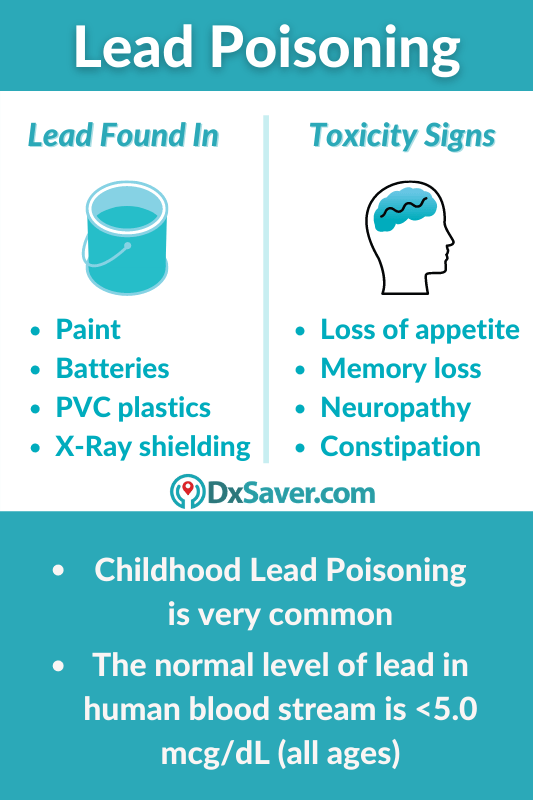Table of Content
Lead’s physical properties, low cost, and ease of use have made it a popular additive to products like cosmetics, pipes, and paint. Lead paint was preferred over other paints because it covers more area, is water resistant, and lasts longer. However, lead is also highly toxic, which is why the federal government regulated its use in consumer goods to prevent widespread lead poisoning.
Transfer your fresh paint sample to a pre-filled vial of Solution 1. Use the chip catcher tray as a funnel to ensure that the paint chip doesn't come into contact with any other surfaces before it goes into the solution. Add the entire sample to the vial, even if it happens to break into smaller pieces.
What are the signs and symptoms of lead poisoning in adults?
If you live in a house or apartment built before 1978, talk to your state or local health department about having your home’s paint and dust tested for lead. Lead poisoning is caused by exposure to high levels of lead. Symptoms of lead poisoning include headaches, cramps and hyperactivity. Lead poisoning can be diagnosed through a blood lead test. Treatment includes finding and removing the source of the lead to prevent further exposure. A healthcare provider will test a child’s blood for lead.

Lead test swabs may not work as well on porous or irregular surfaces, such as raw stone, metal grating, or painted wicker. Crush the indicated points on the test swab to activate it. Locate the points marked “A” and “B” on the outer tube of the swab and squeeze them forcefully one at a time. This will activate the compounds used to detect lead on the test surface.
How to renovate a home that has lead paint
Consider having a paint inspection done when you’re buying a home, signing a lease, or before you renovate. If you’re worried that there might be lead in your home, the first thing to do is find out the year it was built. Thanks to all authors for creating a page that has been read 25,080 times.

If lead is found, you can either remove it yourself or hire someone to do it for you. You can also take simple precautions to reduce the risk of environmental exposure. Because lead can accumulate in the body, the most important step in treatment is to prevent further exposure to lead.
COVID-19 Treatments
If your house was built before 1978 and your lead test kit comes out negative , you should have an accredited lab test the paint to make sure the lead test kit worked properly. Paint on structures built prior to 1978 is legally presumed to be lead-based, unless a state-certified Inspector/Assessor has quantitative testing to show otherwise. The most important areas to test for lead are those areas where children spend a lot of time, such as bedrooms, playrooms, kitchens, and play-yards.
In fact, the EPA says the main source of lead exposure in the United States comes from inhaling dust or eating particles contaminated by paint chips. That’s because lead was a common additive in house paint, gasoline and many other materials for years before its toxicity was known. If you think you or your child may have been exposed to lead, contact your healthcare provider. They’ll ask about your symptoms and have you or your child get a blood lead test. This test will measure the amount of lead in your or your child’s blood. If your child's blood lead level is above average, your health care provider should talk to you about how to reduce the level.
What can adults do to prevent lead poisoning?
Children whose blood tests at those levels should be tested periodically. A child whose levels become too high — generally 45 mcg/dL or higher — should be treated. Although lead in blood represents only a portion of the total amount of lead present in the body, a blood lead test is the best way to assess a person’s exposure to lead. Until you remove lead from these environments—or you remove yourself from these environments—you run the risk of lead poisoning. Lead poisoning treatment involves both limiting your exposure to lead and reducing the amount in your blood. Without treatment, exposure to lead can lead to severe and sometimes irreversible medical problems.
In general, lead paint doesn’t pose a problem unless it chips or flakes. If you notice this happening, carefully remove the flakes and wipe down the area with a wet paper towel. If you must sand the area, wet it before you begin and clean it thoroughly with disposable cleaning products. Using an EP or ZPP assay to screen children for lead exposure is not as useful as once believed, and not recommended. Because hair and fingernails are subject to external environmental contamination, assaying their lead content is an uncertain estimate of body burden and is not recommended [AAP 1993; CDC 2002]. Children with BLLs ≥45 µg/dL or with symptoms of lead poisoning should have an immediate confirmatory test.
If you have lead pipes, stagnant water or hot water can leach lead into your tap water. Let your faucet run cold water for one minute before using for drinking, cooking or making baby formula. Put their hands, toys and other items covered with lead dust in their mouths. Lead is a naturally occurring poisonous metal found in small amounts in the earth’s crust.
Don’t remove paint with an open flame torch because this can also create small lead particles that you could ingest. Tells you if your home has lead-based paint and where it is located. It will not tell you whether your home currently has lead hazards or how to deal with it. This is most helpful when buying a home or signing a lease, before renovating.
The decision to treat is an individual one based on a review of the potential benefits and risks. Discuss any lead concerns with your healthcare provider or your child's practitioner. Contact your local health department to have your paint tested for lead.

Try not to sand, which generates dust particles that contain lead. If you're pregnant or planning a pregnancy, be especially careful to avoid exposure to lead. Lead particles from leaded gasoline or paint settle on soil and can last years.

No comments:
Post a Comment